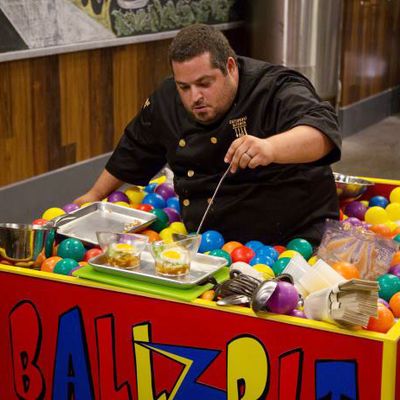
On the surface, I am not the ideal Cutthroat Kitchen viewer. I cook rarely, and poorly; I almost never watch the Food Network, or shows about food; the dish that I prepare best is Maruchan Ramen (Beef Flavor).
And yet over the past few weeks, I have watched dozens of hours of Cutthroat, one episode after another, like links of sausage tied together at the ends. I can’t stop. The show completed its eighth season (in two years’ time) on Sunday, and this evening, a spinoff version called Camp Cutthroat premieres. In the time that I’ve spent watching Cutthroat Kitchen and will spend watching Camp, I could have learned to cook like a professional chef. And yet I’m still watching. You should be, too. Cutthroat Kitchen is delirious, consistently entertaining television.
What makes it so satisfying, even to someone who does not enjoy cooking or cooking shows? Cutthroat isn’t really a cooking show. It is not a show about cuisine. I have never come away from an episode of Cutthroat Kitchen inspired to cook anything. I cannot remember a single dish that any of the competitors ultimately prepared; it is quite possible that, on certain episodes of the show, no actual cooking occurs, and I just didn’t notice.
See, the star of Cutthroat Kitchen is never the food, or the chefs, or even the manic, ever-likable Alton Brown. Instead, Cutthroat Kitchen is that rare reality show where the writers really shine. In Cutthroat Kitchen, the (invisible) writers feel present, ruining dishes, sowing chaos. The show’s title may refer to chefs trying to cut each other’s throats; really, though, the stars are the writers who invent the knives. It’s commonly known that reality-show producers pull the strings on their shows, but Cutthroat bakes the string-pulling straight into its premise.
For the uninitiated, Cutthroat Kitchen presents itself as a straightforward cooking competition. Four chefs compete to make the best version of a single dish in an allotted amount of time; we watch as each chef talks through preparing the meal. At the end of the allotted time, a celebrity chef arrives to taste each dish, eliminating one competitor each round. At the end of three rounds, a winner is crowned, and he or she walks home with a certain amount of money.
How much money the winner takes home depends on the show’s central conceit. Each chef is given $25,000 at the start of the show. Before and during each cooking round, a series of “sabotages” is auctioned off by host Alton Brown to the highest bidder. So, if you offer to pay the most, you can force your competitors to cook while jumping through certain hoops: For example, you can make them do all of their cooking in Tupperware. Or replace their knives with plastic cutlery. Or make them walk around on stilts.
It is a classic comedic conceit with infinite possibilities, and as the seasons have gone on, the writers have gotten more creative. The sabotages have become more absurd, satisfying, and central to the show’s continuing success; the food prepared is beside the point, and I’m sure this is the reason why the contestants on the show never give their last names or the names of the restaurants where they work.
What started as a slightly wicked cooking competition now has more to do with Wild and Crazy Kids than it does with Chopped: The sabotages are messy, colorful, outrageous, and inventive. You end up admiring the creators of the obstacles more than the chefs who overcome them. This semi-scripted programming is provocative, even inspiring, to watch as a writer. I often wonder what sabotages I would be able to come up with were I to write for Cutthroat Kitchen. Do I have a running list in my head? Yes, I do. Do I often imagine what it would be like to cook using nothing but a hockey stick and and dry ice?
Sure. How could I not?
That’s a credit to the imagination of the writers, who took a basic joke structure and jammed on it. Cutthroat Kitchen is such a great central idea that it could take place in any industry. It could be called Cutthroat Garden Care, or Cutthroat Bikini Waxers, with pro landscapers and salon workers attempting to complete their tasks with creative impediments blocking their progress. There could be an entire Cutthroat channel. God knows I would tune in, slurping endless bowls of ramen while barbers tried to give haircuts using nothing but garden shears.
Camp Cutthroat is an appropriate spinoff theme for what has become one of the campiest and most delight-filled shows on the air. Advertisements show a chef attempting to crack an egg by dropping it dozens of feet above a stove; another chef is chased from his cooking station by someone wearing a bear costume. Alton Brown runs around maniacally in a well-tailored camp-counselor outfit. “I hate camp,” a woman exclaims, attempting to prepare what looks to be a burrito while suspended from a rock-climbing wall.
Am I going to learn anything at all about cuisine or kitchen techniques from Camp Cutthroat? Probably not. Will I be watching, wondering if the chefs will be able to finish cooking a s’more while floating in a canoe in the middle of the lake? Absolutely.

